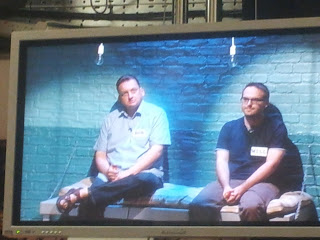GIVE IT ANOTHER GO.COM:
THE MONSTER OF PELADON
Re-evaluation of the Third
Doctor’s penultimate story, the sequel to 1972's 'The Curse of Peladon', reveals an undervalued gem.
 |
| The superb Radio Times illustrations for the story. (Image: Radio Times) |
Season 11 of Doctor Who is a great deal better than that old rascal Received
Wisdom would have us believe. According to Mr Wisdom, apart from ‘The Time
Warrior’ (which introduced Elisabeth Sladen’s Sarah Jane Smith and the
Sontarans), the series is marking time until Jon Pertwee leaves. The three
stories leading up to ‘Planet of the Spiders’ rehash past glories from the
previous four years and/or are hobbled by poor special effects.
OK, the giant reptile models in
‘Invasion of the Dinosaurs’ aren’t great, but they’re so tangential to the main
point of the story, that condemning Malcolm Hulke’s thought provoking tale of
green politics gone wrong because of them is something only hard core fans,
hung up on the quality of production values, could do. After the Famous Five
with adults tone of UNIT over the past two years, the security organisation is
back to being unpredictable. Yates is a traitor (if a well meaning and
misguided one) and at one point the Doctor wonders if even the Brigadier could
be part of the dinosaur conspiracy.
‘Death to the Daleks’ (the third
story in Season 11) apart from being innovatively directed by Michael E. Briant
– witness the threatening, shadowy interior of the disabled TARDIS and the
psychedelic, mind-scrambling attack on the Doctor and Bellal – gives the
series’ most over familiar monsters fresh things to do. Mr Wisdom always says
that writer Terry Nation rediscovered his mojo on his next script ‘Genesis of
the Daleks’, but working with script editor-in-waiting Robert Holmes makes him
raise his game in his 1974 screenplay too.
The Daleks can’t kill, so they’re
forced into an uneasy alliance with the Doctor’s party. At least publicly:
other Daleks hidden in their spacecraft develop mechanical weapons and emerge
to stage a successful coup over the humans and the Exxilons. Apart from a
couple of stupidly hysterical Daleks, the machine creatures are back to a level
of characterisation consistent with ‘The Evil of the Daleks’ – curiously
enough, since Nation claimed to dislike David Whitaker’s two Dalek stories.
Their plan to use the cure for a space plague to blackmail infected planets is
a scheme of ‘The Daleks’ Master Plan’ vintage.
Which brings us to ‘The Monster of
Peladon’. The story is usually dismissed – Mr Wisdom, get your coat – as a
club-footed allegory of the industrial unrest in the UK mining industry in the
early 1970s. That’s only a topical surface detail: like the story’s prequel
‘The Curse of Peladon’, Brian Hayles’ script is broadly political – with a
small ‘p’ – in the tradition producer Barry Letts and script editor Terrance
Dicks established for Doctor Who in
1971. The twists and turns of the story are very nimble for a six parter.
There’s absolutely no padding, unlike the sluggish detour through the moonbase
ventilation system in Hayles’ ‘The Seeds of Death’. (That sequence is so uncharacteristic
of his writing in general, that it must have been put in via in-house
rewrites).
 |
| Another Martian chronicle. (Image: BBC) |
There are very few creative gaffes.
Terry Walsh, doubling for Pertwee in an otherwise brilliant and literally hard
hitting fight with the rebel miner Ettis (Ralph Watson), is briefly but
painfully visible in the Doctor’s costume and wig. In part 6, Max Faulkner is
all too noticeably killed twice in quick succession. The desire of villain
Eckersley (Donald Gee) to be “the ruler of Earth” is very corny given his
practical attitude and reasoning throughout the rest of the story.
Received Wisdom – your taxi’s outside
now – also has us believing that there’s no sense of the Third Doctor’s impending
doom. Wrong again, and the hints about what was going to happen in the next
story are clever because they only become apparent in hindsight. Sarah comments
that the Doctor always said “While there’s life [there’s hope]” and the Doctor,
thought dead by Sarah, is woken by her crying. “Tears?” he wonders. “Anyone
would think you thought I was dead.” Word for word in places, their dialogue
foreshadows the Doctor’s regeneration/death scene and the reference forward is
a remarkably subtle piece of writing. It was so subtle that I completely missed
it when I was 9.
It’s no
wonder that Doctor Who won a Writers Guild
for its scripts in 1974. Deservedly so. It’s also worth stating that one story
before his swan song, Jon Pertwee is still giving the part his all.
Ladies and gentlemen: Received Wisdom has now left the building.
Ladies and gentlemen: Received Wisdom has now left the building.
This year, the BFI Southbank is hosting Doctor Who at 50, a 12-month celebration of the series’ half century. Details of the monthly events can be found here: https://whatson.bfi.org.uk/Online/doctor-who-at-50









